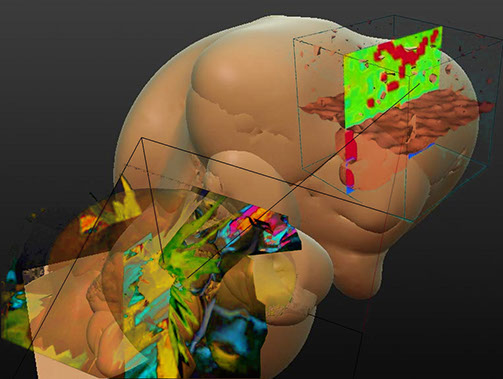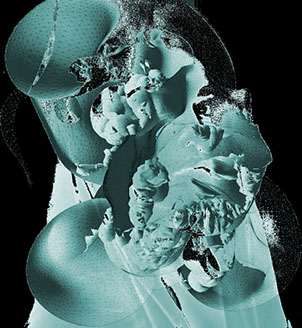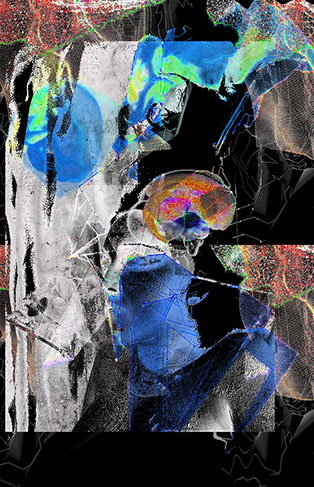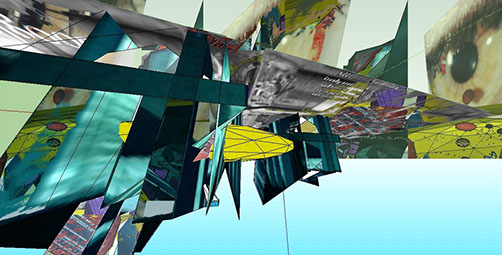

Alex Cruse
Cognitive Mirror Box (2014)
Digital
The Phantom Apparatus
In his 1983 text, Towards a Philosophy of Photography, Vilém Flusser wrote that the value of photographs “does not lie in the thing but in the information on their surface”.i He continues to explain how the photographic object lost its significance with the advent of mechanical printing, subsequently functioning in the same way as a flyer: infinitely reproducible and worthless beyond its purpose of delivering information. Flusser believed that the photographic apparatus had become so integrated in humans’ interaction with the world—a mechanical prosthetic—that the camera users had become “functionaries” of the apparatus’ operations and simulations of thought. Thirty years later in our current digital age, the photographic object is nearly extinct outside of either artistic or novelty contexts. Once rendered in silver-laced gelatin, most photography has indeed become digital information only. Furthermore, with new discoveries and developments in neuroscience and cognitive science, as well as advancements in digital technology, it has become apparent that the threat to our autonomous identities and abilities to assert our conscious wills may be even more critical than Flusser could have imagined.
Learned Paralysis and the Phantom Limb Phenomenon
Flusser suggested that apparatuses are extensions of the human organs whose functions they simulate—ears, eyes, legs, fingers, etc. When considering Flusser’s theories in conjunction with proposals to implement neurological devices to replace the tangible technologies we already use as extensions of our bodies, these new prostheses may lead to the development of a kind of cognitive phantom apparatus.ii The perception of a phantom limb occurs when someone has an extremity amputated, but the brain continues trying to communicate with the absent limb resulting in the perception that it is still present. In some cases when patients’ limbs are paralyzed before removal, they continue experiencing paralysis in the phantom limb, which frequently results in chronic or extreme pain caused by the sensation that the absent limb is clenched. If we continue allowing the degradation of our bodies and minds through the conveniences of technology, we are in danger of unknowingly preparing ourselves for a phantom apparatus paralysis. I am suggesting that such a condition could cause further dissociation from the perceived world and threaten our free will, rendering us in a dire state of cognitive paralysis.
Fortunately, this can be prevented thanks to the plasticity of the human brain. Our experiences modify our brains by strengthening or weakening the synapses that link neurons. Neuroscientist, Dr. V.S. Ramachandran demonstrated that, when a patient’s limb lays immobile but intact for a prolonged period of time prior to amputation, the motor signals sent to the brain become weaker and weaker and eventually abate entirely. As a result, the brain “learns” that the limb is paralyzed from each disabled motor signal,To “cure” patients of this “learned paralysis,” Dr. Ramachandran developed a simple device—notably lacking any need for

Alex Cruse
Expanded Data Spheres (2014)
Digital
digital technology—to trick the brain into thinking it is communicating with the absent limb: a box with a mirror separating two compartments. For the example of an amputated arm, the patient puts both arms in the box with a mirror reflecting the intact arm and creating the illusion that the patient’s vestigial arm is also still intact. The patient then moves the fingers on the intact hand. When the patient sees the reflection of their intact hand move, their brain perceives that as the phantom limb moving and the muscles relax, relieving the pain. Dr. Ramachandran and several other researchers in the field have successfully utilized mirror visual feedback (MVF) in the rehabilitation of phantom limb paralysis as a way to help patients’ brains “unlearn” the learned paralysis iii Phantom paralysis can be a debilitating disability for those with amputated limbs, but the stakes are even higher when our conscious minds are the affected organs. By practicing self-reflection, we can hope to “cure” the paralysis of our phantom apparatuses and maintain self-awareness and our ability to exercise free will.
Free Will in the First Place?
Flusser’s assertion that humans have lost their ability to control the technologies they created—becoming the instruments of their own inventions—presumes that humans have control over their conscious decisions to begin with. In the 1960s, however, Benjamin Libet discovered that an unconscious electrical charge—what he called “readiness potential”—occurs in the brain before humans experience the conscious thought associated with free will and decision-making. The simple example used by Libet was the action of moving one’s wrist. The previous notion of the progression of acts was as follows: the subjects make the conscious choice to move their wrist: then the brain tells the wrist to move: then the wrist moves. Contradicting this notion, Libet discovered that the “readiness potential” prepares the brain to make conscious decisions 200–300 milliseconds before subjects become aware of the intention to act, and 500ms before the motor act.iv In 2007 and with the use of more sophisticated brain scans, neuroscientist John-Dylan Haynes recorded “readiness potential” as many as seven seconds before decision-making.v While some theorists use this information to argue against the existence of what we consider to be conscious free will—saying that this unconscious neurological function essentially wills us to will—Libet was clear in his support of our ability to make conscious decisions after the readiness potential prepares us to make them:
The volitional process is therefore initiated unconsciously. But the conscious function could still control the outcome; it can veto the act. Free will is therefore not excluded. These findings put constraints on views of how free will may operate; it would not initiate a voluntary act but it could control performance of the act.vi
Suggesting the absence of what we consider to be free will—perhaps the most omnipresent human concern—is extremely problematic. But the conscious function could still control the outcome; it can veto the act. It is because of this tenuous control of self-direction that we must put the highest priority on
protecting and strengthening the integrity of our conscious identities: to ensure we always maintain the ability to “veto” unconscious acts originating in our brains. Philosophers have debated over the topic of free will for centuries; David Hume called it “the most contentious question of metaphysics.” vii Because of the continual assertion that we are in control of our minds and not under the control of some unknown entity—whether it be non-human or our very own brains—many scientists, theorists and inventors are looking at our conscious minds asnew environments for digital or mediated experience and communication rather than searching for ways to emphasize cognitive autonomy. These diversions may lead to an even more complete disembodiment than Flusser predicted: instead of regaining control of the devices we created, we will become further ignorant of our increasing enslavement.

Alex Cruse
intraveillance (2014)
Digital
A Future of Predetermined Choices
In her 2009 TED Talk, Pattie Maes, head of MIT’s media lab’s Fluid Interfaces Group, and her student Pranav Mistry, presented their prototype for SixthSense, a ”wearable gesture interface”.viii The device combines a webcam; a portable, battery powered projection system; a mobile communication and computation device (mobile phone); and four, colored markers placed on the index fingers and thumbs. SixthSense would allow users to apply digital media and information to their real-world interactions. For example: at the supermarket, when choosing between different brands of toilet paper, the camera would recognize the brands and inform you which is best suited for your predetermined preferences. In her presentation, Maes stresses that the objective of SixthSense is to “help people make the right decisions.” While the prototype is extremely bulky and under-designed – an aggregate of the individual devices used- Mae admits that, while it is very much a work in progress, Maes hopes in ten years to be able to present the ultimate SixthSense brain implant.
Many would dismiss this notion as the stuff of science fiction: however, the theories and experiments of computer scientist, Mary Lou Jepsen, suggest digital brain implants may be more feasible than we realize. Jepsen, who is the head of the Display Division at Google, underwent brain surgery resulting in the removal of a piece of her brain matter. The experience ignited a curiosity in brain sciences, culminating in a proposal for technology that could lead to what is, in essence, a form of telepathy. Through the use of many extremely high-resolution FMRI (Functional Magnetic Resonance Imaging) brain scans, which will then be decoded by digital media and sent via FM radio waves to other brains, we can transcend oral language through the use of our thoughts alone.
Jepsen believes that this could release our interactions from the binds of self-censorship, and result in a pure form of information transference.ix And keeping with Flusser’s primacy of information, many may see this as a revolutionarily beneficial development. The pitfall of this mindset is that our status as functionaries of the technologies will likely become difficult to reverse. Today, already, the security and privacy of our personal information is at risk when using the Internet, cell phones, and other digital devices—all these things that remain separate from our corporeal existence. But what will happen if we introduce biotechnology that records our thoughts and movements from within our bodies?
Flusser described the hegemonic preference of information to objects in post-industrial society, and claimed that the human body has become the plaything of the tools and machines we created to enhance our abilities. Considering the signs of diluted social interaction and hyper-externalization on the Internet and social media devices such as SixthSense and those proposed by Mary Lou Jepsen could carry society even deeper under the hypnotic power of our technologies. Libet’s discovery of “readiness potential,” if our conscious thought process makes the integral components facilitating free will and asserting control over unconscious processes, is further warning that we should be skeptical of any invasion on the final frontier of our autonomy: conscious thought.
As demonstrated by Dr. Ramachandran, if we allow ourselves to atrophy into states of learned paralysis through the continual disengagement of our minds and bodies via the devices designed to help us function “better,” we risk developing a phantom cognitive paralysis in the absence of our biological tools for internal thought processes and communication with others. Whether feeling the loss of corporeal, psychological, or social interaction, the only way to relieve the unrelenting insensitivity will be through human beings’ unique capability of self-reflection

1 Flusser, Vilém. Towards a Philosophy of Photography. London: Reaktion, 2000. 53.
ii Ibid., 23.
3 Ramachandran, V. S. "Phantom Limbs and Plastic Brains." The Tell-Tale Brain: A Neuroscientist's Quest for What Makes Us Human. New York: W.W. Norton, 2011. 24–40.
4 Libet, Benjamin, Journal of Consciousness Studies, 6, No. 8 Benjamin, Journal of
v Smith, Kerri. "Neuroscience vs philosophy: Taking aim at free will." Nature.com. Nature Publishing Group, 31 Aug. 2011. Web. <http://www.nature.com/news/2011/110831/full/477023a.html>.
vi Libet, Benjamin, Journal of Consciousness Studies, 6, No. 8–9, 1999, pp. 47–57.
vii Hume, D. (1748) Enquiry Concerning Human Understanding, Oxford: Clarendon Press, 1975, §VIII. (Famous statement of the case for compatibilism, following Hobbes and Locke.)
viii Maes, Pattie, and Pranav Mistry. "Meet the SixthSense Interaction." www.TED.com, <http://www.ted.com/talks/pattie_maes_demos_the_sixth_sense>.
5 Jepsen, Mary Lou. "Could Future Devices Read Images from Our Brains?” www.TED.com. <http://www.ted.com/talks/mary_lou_jepsen_could_future_devices_read_images_from_our_brains>.
Alex Cruse
skeins of hyper-absence (2014)
Digital
Disclaimer: All views and opinions expressed are those of the authors and do not necessarily reflect the views of the editors, owner, advertisers, other writers or anyone else associated with PAINTING IS DEAD.
